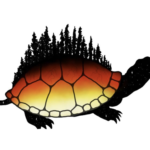Who Are the Anishinaabeg?
Big Ideas
- The Anishinaabeg territory spans across a large geographic area and is very diverse.
- The lands and waters can not be owned but rather looked after.
- The Anishinaabeg have roles and responsibilities to care for each other as well as the lands, waters and all of creation.
- These roles and responsibilities are outlined in Chi-Naaknigewin and other laws that are part of the governing system of the Anishinaabeg.
- The territory that the Anishinaabeg occupy is shared between many other Indigenous nations even prior to European contact with agreements outlining each other’s roles and responsibilities.
- Agreements were made with the early settlers and their colonial governments to share the land. These agreements outlined the terms and conditions for land sharing.
- The British and later Canada used the treaty making process to illegally steal and occupy Anishinaabeg territory.
- Canada created laws such as the Indian Act to justify the theft of land and genocide of the Anishinaabeg.
- Today the Anishinaabeg are seeking to reassert their jurisdiction over their lands and recover from the attempts of genocide.
- The Anishinaabeg never ceded or surrendered their lands.
The Anishinaabeg territory
The Anishinaabeg are a large group of Indigenous people that span all the way from Quebec right through to the Rocky Mountains all the way down to Oklahoma up through to Ottawa.
The Anishinaabeg are also organized into other groups including: Naakowe, Mississauga, Odishwaagaamii’ininiwag, Amikwaa, Boodiwaadmi, Ojibwe, Odaawa.
Note: there are many regional variances and dialectical differences with Anishinaabemowin. These names may be spelled or pronounced differently depending on who you speak to.
Nswi – Shkodewin: Three Fires Confederacy
A confederacy between the Boodiwaadmi, Ojibwe and the Odaawa that pre-existed before European contact. This confederacy outlined a process on how the relationship with the settlers would occur. The Odaawa would trade goods with the settlers and form relationships with them in terms of trading. The Ojibwe would be the knowledge keepers and would pass this down to all of the nations. The Boodiwaadmi were to take care of the three fires (nations) and make sure they were strong. The fire is central to the governance structure and continues to be so to this day. All the different groups have their own roles and responsibilities to ensure the nation as a whole thrives.
Political Territorial Organizations
After centuries of violent colonization, the Anishinaabeg are working to restore jurisdiction over their territories. It is important to recognize that there are different forms of organizing and that not all political organizations today represent every Anishinaabe citizen. Many people and communities are working at a grass roots level to restore and assert their original governing system as it was prior to colonization. Others have formed post colonial political organizations such as the ones listed here. These political territorial organizations allow for services to support the communities they serve.
Click on each logo to learn more:








